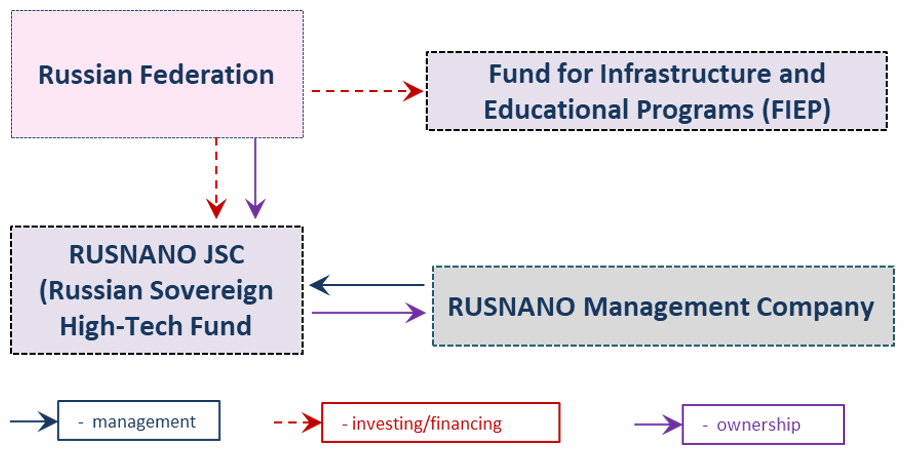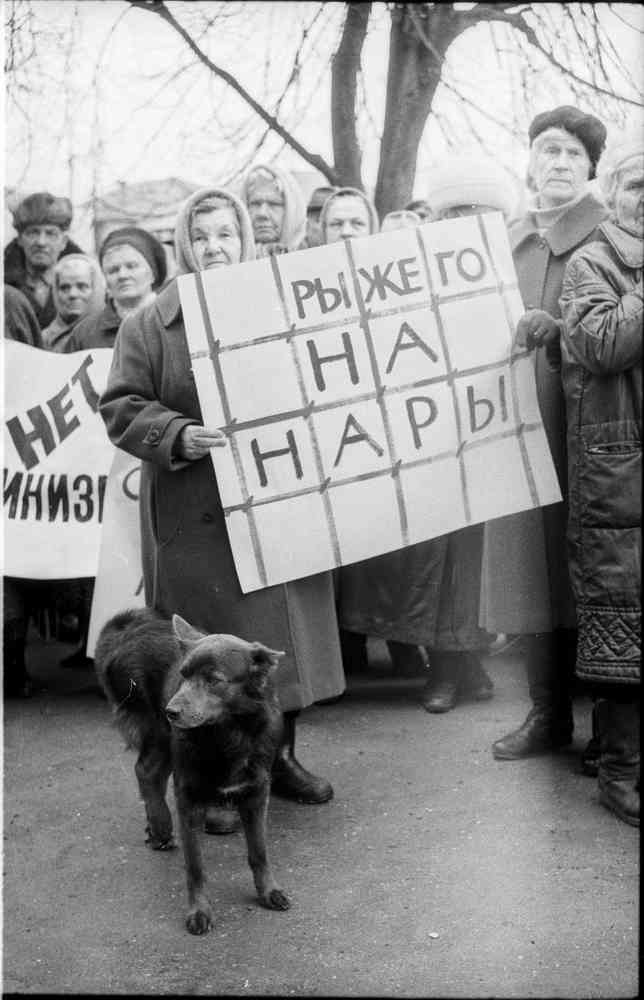|
RUSNANO
Rusnano Group () is a Russian state-established and funded company. The Rusnano Group's mission is to create competitive nanotechnology-based industry in Russia. Rusnano invests directly and through indirect funds into all major knowledge-based areas where nanotechnology is widely implemented: electronics, optics, Telecommunication, telecom, classic and renewable energy, healthcare and biotechnology, materials and metallurgy, engineering and chemistry. In 2020 the government of Russia has merged it with VEB.RF. As of 2017 100% shares of Rusnano were owned by the Russian government. In 2015 Rusnano had 16 investment projects. It invested into about 97 plants and R&D companies in 37 regions of Russia. In 2016 many such enterprises were either dissolved, bankrupted or repurposed (see. below). In 2016 the company was on the verge of bankruptcy significantly Devaluation, devaluating below the Equity (finance), equity levels but managed to recover. In November 2021 trade of company's ... [...More Info...] [...Related Items...] OR: [Wikipedia] [Google] [Baidu] |
Anatoly Chubais
Anatoly Borisovich Chubais (; born 16 June 1955) is a Russian- Israeli politician and economist who was responsible for privatization in Russia as an influential member of Boris Yeltsin's administration in the early 1990s. During this period, he was a key figure in introducing a market economy and the principles of private ownership to Russia after the fall of the Soviet Union. He has the federal state civilian service rank of 1st class Active State Councillor of the Russian Federation. He fled to Israel in 2022 and subsequently obtained Israeli citizenship. From 1998 to 2008, he headed the state-owned electrical power monopoly RAO UES. A 2004 survey conducted by PricewaterhouseCoopers and the ''Financial Times'' named Chubais the world's 54th most respected business leader. He was the head of the Russian Nanotechnology Corporation (RUSNANO) from 2008 to 2020. [...More Info...] [...Related Items...] OR: [Wikipedia] [Google] [Baidu] |
Joint-stock Company
A joint-stock company (JSC) is a business entity in which shares of the company's stock can be bought and sold by shareholders. Each shareholder owns company stock in proportion, evidenced by their shares (certificates of ownership). Shareholders are able to transfer their shares to others without any effects to the continued existence of the company. In modern-day corporate law, the existence of a joint-stock company is often synonymous with incorporation (possession of legal personality separate from shareholders) and limited liability (shareholders are liable for the company's debts only to the value of the money they have invested in the company). Therefore, joint-stock companies are commonly known as corporations or limited companies. Some jurisdictions still provide the possibility of registering joint-stock companies without limited liability. In the United Kingdom and in other countries that have adopted its model of company law, they are known as unlimited ... [...More Info...] [...Related Items...] OR: [Wikipedia] [Google] [Baidu] |
Chemistry
Chemistry is the scientific study of the properties and behavior of matter. It is a physical science within the natural sciences that studies the chemical elements that make up matter and chemical compound, compounds made of atoms, molecules and ions: their composition, structure, properties, behavior and the changes they undergo during chemical reaction, reactions with other chemical substance, substances. Chemistry also addresses the nature of chemical bonds in chemical compounds. In the scope of its subject, chemistry occupies an intermediate position between physics and biology. It is sometimes called the central science because it provides a foundation for understanding both Basic research, basic and Applied science, applied scientific disciplines at a fundamental level. For example, chemistry explains aspects of plant growth (botany), the formation of igneous rocks (geology), how atmospheric ozone is formed and how environmental pollutants are degraded (ecology), the prop ... [...More Info...] [...Related Items...] OR: [Wikipedia] [Google] [Baidu] |
Photonics
Photonics is a branch of optics that involves the application of generation, detection, and manipulation of light in the form of photons through emission, transmission, modulation, signal processing, switching, amplification, and sensing. Even though photonics is a commonly used term, there is no widespread agreement on a clear definition of the term or on the difference between photonics and related fields, such as optics. Photonics is closely related to quantum electronics, where quantum electronics deals with the theoretical part of it while photonics deal with its engineering applications. Though covering all light's technical applications over the whole spectrum, most photonic applications are in the range of visible and near-infrared light. The term ''photonics'' developed as an outgrowth of the first practical semiconductor light emitters invented in the early 1960s and optical fibers developed in the 1970s. History The word 'Photonics' is derived from the Greek w ... [...More Info...] [...Related Items...] OR: [Wikipedia] [Google] [Baidu] |
Nanoelectronics
Nanoelectronics refers to the use of nanotechnology in electronic components. The term covers a diverse set of devices and materials, with the common characteristic that they are so small that inter-atomic interactions and quantum mechanical properties need to be studied extensively. Some of these candidates include: hybrid molecular/semiconductor electronics, one-dimensional nanotubes/nanowires (e.g. carbon nanotube or silicon nanowires) or advanced molecular electronics. Nanoelectronic devices have critical dimensions with a size range between 1 nm and 100 nm. Recent silicon MOSFET (metal–oxide–semiconductor field-effect transistor, or MOS transistor) technology generations are already within this regime, including 22 nanometers CMOS (complementary MOS) nodes and succeeding 14 nm, 10 nm and 7 nm FinFET (fin field-effect transistor) generations. Nanoelectronics is sometimes considered as disruptive technology because present candidates are significantly d ... [...More Info...] [...Related Items...] OR: [Wikipedia] [Google] [Baidu] |
Nanomaterials
Nanomaterials describe, in principle, chemical substances or materials of which a single unit is sized (in at least one dimension) between 1 and 100 nm (the usual definition of nanoscale). Nanomaterials research takes a materials science-based approach to nanotechnology, leveraging advances in materials metrology and synthesis which have been developed in support of microfabrication research. Materials with structure at the nanoscale often have unique optical, electronic, thermo-physical or mechanical properties. Nanomaterials are slowly becoming commercialized and beginning to emerge as commodities. Definition In ISO/TS 80004, ''nanomaterial'' is defined as the "material with any external dimension in the nanoscale or having internal structure or surface structure in the nanoscale", with ''nanoscale'' defined as the "length range approximately from 1 nm to 100 nm". This includes both ''nano-objects'', which are discrete pieces of material, and ''nanostructu ... [...More Info...] [...Related Items...] OR: [Wikipedia] [Google] [Baidu] |
Куликов СА (cropped)
Kulikov (), or Kulikova (feminine; Кулико́ва), is a common Russian last name and may refer to the following: People * Anatoly Kulikov (b. 1946), a Russian Minister of the Interior in 1995-1997 * Artyom Kulikov (b. 1980), a Russian football manager and a former player * Denis Kulikov (b. 2004), an Israeli football player * Dmitri Kulikov (b. 1977), an Estonian football player * Dmitri Kulikov (b. 1990), a Russian ice hockey player * Georgi Kulikov (b. 1947), a Latvian swimmer * Irina Kulikova (b. 1991), a Russian fashion model * Ivan Kulikov, (1875–1941), a Russian painter * Konstantin Kulikov (1896–1944), Soviet general * Leonid Yakovlevich Kulikov, (1914-2001), a Soviet mathematician, contributor to Abelian group theory * Vasily Kulikov (1923–1991), a Soviet army officer and Hero of the Soviet Union * Vasily Kulikov (1921–1943), a Soviet army officer and Hero of the Soviet Union (posthumously) *Viktor Kulikov (1921–2013), a Soviet military leader and Marshal of t ... [...More Info...] [...Related Items...] OR: [Wikipedia] [Google] [Baidu] |
Non-profit Organization
A nonprofit organization (NPO), also known as a nonbusiness entity, nonprofit institution, not-for-profit organization, or simply a nonprofit, is a non-governmental (private) legal entity organized and operated for a collective, public, or social benefit, as opposed to an entity that operates as a business aiming to generate a Profit (accounting), profit for its owners. A nonprofit organization is subject to the non-distribution constraint: any revenues that exceed expenses must be committed to the organization's purpose, not taken by private parties. Depending on the local laws, charities are regularly organized as non-profits. A host of organizations may be non-profit, including some political organizations, schools, hospitals, business associations, churches, foundations, social clubs, and consumer cooperatives. Nonprofit entities may seek approval from governments to be Tax exemption, tax-exempt, and some may also qualify to receive tax-deductible contributions, but an enti ... [...More Info...] [...Related Items...] OR: [Wikipedia] [Google] [Baidu] |
Vladimir Putin
Vladimir Vladimirovich Putin (born 7 October 1952) is a Russian politician and former intelligence officer who has served as President of Russia since 2012, having previously served from 2000 to 2008. Putin also served as Prime Minister of Russia from 1999 to 2000 and again from 2008 to 2012. He is the longest-serving Russian president since the independence of Russia from the Soviet Union. Putin worked as a KGB foreign intelligence officer for 16 years, rising to the rank of Lieutenant colonel (Eastern Europe), lieutenant colonel. He resigned in 1991 to begin a political career in Saint Petersburg. In 1996, he moved to Moscow to join the administration of President Boris Yeltsin. He briefly served as the director of the Federal Security Service (FSB) and then as Secretary of the Security Council of Russia, secretary of the Security Council of Russia before Putin's rise to power, being appointed prime minister in August 1999. Following Yeltsin's resignation, Putin became Actin ... [...More Info...] [...Related Items...] OR: [Wikipedia] [Google] [Baidu] |
Anton Siluanov
Anton Germanovich Siluanov ( rus, Анто́н Ге́рманович Силуа́нов, p=ɐnˈton ˈɡʲɛrmənəvʲɪtɕ sʲɪlʊˈanəf; born 12 April 1963) is a Russian politician and economist. He has the federal state civilian service rank of 1st class Active State Councillor of the Russian Federation. In 2011, he was appointed Minister of Finance by Prime Minister Vladimir Putin substituting in this position Alexei Kudrin, who was forced out and dismissed by President Dmitry Medvedev after publicly criticizing the additional defense spending of 2.1 trillion rubles (US$66 billion) through 2014. Siluanov served as First Deputy Prime Minister of Russia from 2018 to 2020. Biography In 1985, Siluanov graduated from the Moscow Finance Institute with a degree in "Finance and credit". In 1994, he obtained a PhD degree in economics (Russian nomenclature for the degree is кандидат экономических наук). From August 1985 to March 1987, Siluanov served ... [...More Info...] [...Related Items...] OR: [Wikipedia] [Google] [Baidu] |
Ruble
The ruble or rouble (; rus, рубль, p=rublʲ) is a currency unit. Currently, currencies named ''ruble'' in circulation include the Russian ruble (RUB, ₽) in Russia and the Belarusian ruble (BYN, Rbl) in Belarus. These currencies are subdivided into one hundred kopeks. No kopek is currently formally subdivided, although '' denga'' (½ kopek) and ''polushka'' (½ denga, thus ¼ kopek) were minted until the 19th century. Additionally, the Transnistrian ruble is used in Transnistria, an unrecognized breakaway province of Moldova. Historically, the grivna, ruble and denga were used in Russia as measurements of weight. In 1704, as a result of monetary reforms by Peter the Great, the imperial ruble of the Russian Empire became the first decimal currency. The silver ruble was used until 1897 and the gold ruble was used until 1917. The Soviet ruble officially replaced the imperial ruble in 1922 and continued to be used until 1993, when it was formally replaced with the Russi ... [...More Info...] [...Related Items...] OR: [Wikipedia] [Google] [Baidu] |








